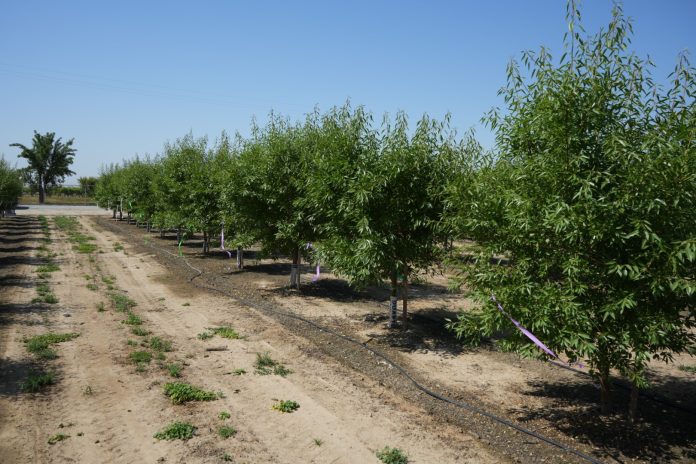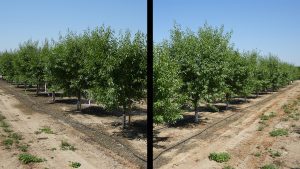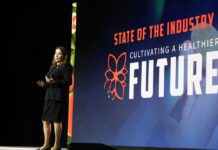
Soil fumigation is a practice that has been used for ages to control soilborne pests and mitigate destructive diseases. However, with raised input costs, increased chemical regulation in California and a larger market-based push for using more sustainable options, finding alternatives to fumigation is an important focus being explored by industry experts and the Almond Board of California (ABC).
Growers want to ensure these alternatives are as impactful as fumigation, especially in eliminating the possible threats to their crop. And so, the challenge lies in ensuring these adopted practices are effective and economically feasible for the grower.
For example, prunus replant disease (PRD), a soilborne disease that affects various plants in the Prunus genus and manifests when you plant a new prunus species after you remove a prunus species on the same soil, is one of those threats believed to only be treated by fumigation. This disease causes growth stunting and yield reduction in the very early life of an orchard, and it tends to dissipate with the years of life of an orchard. Various soil types and rootstocks are factors that can influence the disease’s severity.
Though it does vary by soil type, growers can typically cut the severity of the problem by about half with each year of fallow, said Greg Browne, research plant pathologist at USDA-ARS. However, intentionally fallowing land is obviously a complicated strategy from a grower’s financial point of view.
Diagnosing PRD
Because of this disease’s variation, diagnosing PRD can be challenging, which is why ABC has actively invested in research to help provide answers to growers.
In one study led by Browne, 25 soil samples were taken throughout the Central Valley, and a bioassay was conducted to assess the severity of PRD. Their findings showed no correlation between the disease’s severity and phytopathogenic nematode counts, but they did discover certain regions of California with a higher soil pH can be more susceptible to PRD.
The focus of this study, however, was to assess the microbial root population in the soil to determine if certain microbes indicate a problem.
“We found shifts in the communities, but no specific targets in the soil that you could detect and use as an indicator in roots,” Browne said. “What it did is focus our attention on elements of the microbial community in bacterial domain.”
Anaerobic Soil Disinfestation as a Solution
While fumigation is traditionally the most effective form of management for PRD, holistically, it is not the best approach.
“For many reasons, economic, environmental and so on, we really need to be looking at alternatives to fumigation in the long run,” Browne said.
ABC is investing in research to examine alternatives, and one of the most successful methods looked at is known as anaerobic soil disinfestation (ASD). The process consists of adding a carbon substrate to the soil, covering it with a tarp and maintaining soil moisture at field capacity for four to eight weeks.
There is a diverse list of carbon substrates that can be used, but in phase one of the trials conducted by Browne in part with ABC, rice bran was first evaluated. The researchers used an auxiliary drip system to sustain water levels, and a TIF tarp was utilized.
The outcomes showed a reassuring shift in microbials that suppress nematodes, other pathogens and microbials that cause PRD. Tree yields using either preplant soil fumigation or ASD also more than doubled on orchards affected by PRD, proving its ability to be as effective as fumigation.

The caveats growers will find with this type of treatment are cost and practicality of implementation. Using ASD, one acre is estimated at $2,000+, while soil fumigation is estimated at $820 per acre. Rice bran is also not widely available in California.
Because of this, a second trial was conducted, this time using a different carbon substrate that would likely be less expensive without comprising fertility.
“We have tested quite a range of substrates for driving ASD,” Browne said. “We went to focusing on two that we felt had the most potential: rice bran and ground-up almond hull and shell.”
Browne said they also assessed if water moisture and a tarp were necessary to get the same results and how to incorporate mechanization so it could be performed on a larger scale.
After multiple trials with the two substrates, the researchers concluded that when compared to almond hulls and shells, rice bran resulted in more consistent growth and yield.
Almond hull and shell are still a powerful option when applying ASD, though the one downfall is it is not strong enough to be just an amendment alone.
“We found when we took the process apart that much of the rice bran benefit occurred even without water and tarp,” Browne said. “There’s a lot of benefit from just the rice bran as an amendment alone.”
Cost was also another factor analyzed in their trial. The researchers treated row strips that constituted half the orchard area, which showed that alternatives to fumigation can vary but are generally more expensive than a fumigation treatment.
So, what does this mean for tree growth? Browne said in their most recent trials, rice bran not only proved to be an asset in making ASD a viable substitute, but it also benefited tree growth.
“We really didn’t achieve anything with water and tarp treatments alone, but when we add rice bran amendment alone, we got a big increase in tree growth,” Browne said. “If we did the full rice bran and tarp ASD, we got another increment of improvement, even better than the jump that we got from preplant fumigation.”
On the other hand, ground almond hull and shell was not as successful, though still comparable to fumigant levels.
Simultaneously, they also conducted three fertilization treatments within these test plots: standard nitrogen, a high-end nitrogen and standard nitrogen and phosphorus.
“The nest fertilization treatments were not as impactful as the effective ASD or fumigation treatments, but you do see that we got a significant response to phosphorus,” Browne said.
Browne noted continued refinement is needed of these amendment-based approaches, and ABC continues to invest in research to provide growers with the best resources and strategies.
“In my view, the work in this area is a prime example of how long-term commitment and vision in the research method bring solutions to practical challenges that are particular to our almond growers,” added Sebastian Saa, associate director of agricultural research at ABC.
“As we move ahead and get to implementing some of these experimental strategies for management of the soil, we’re going to have to think about substrate supplies, transport issues for these substrates and how plentiful and widely available they’re going to be,” Browne concluded.















